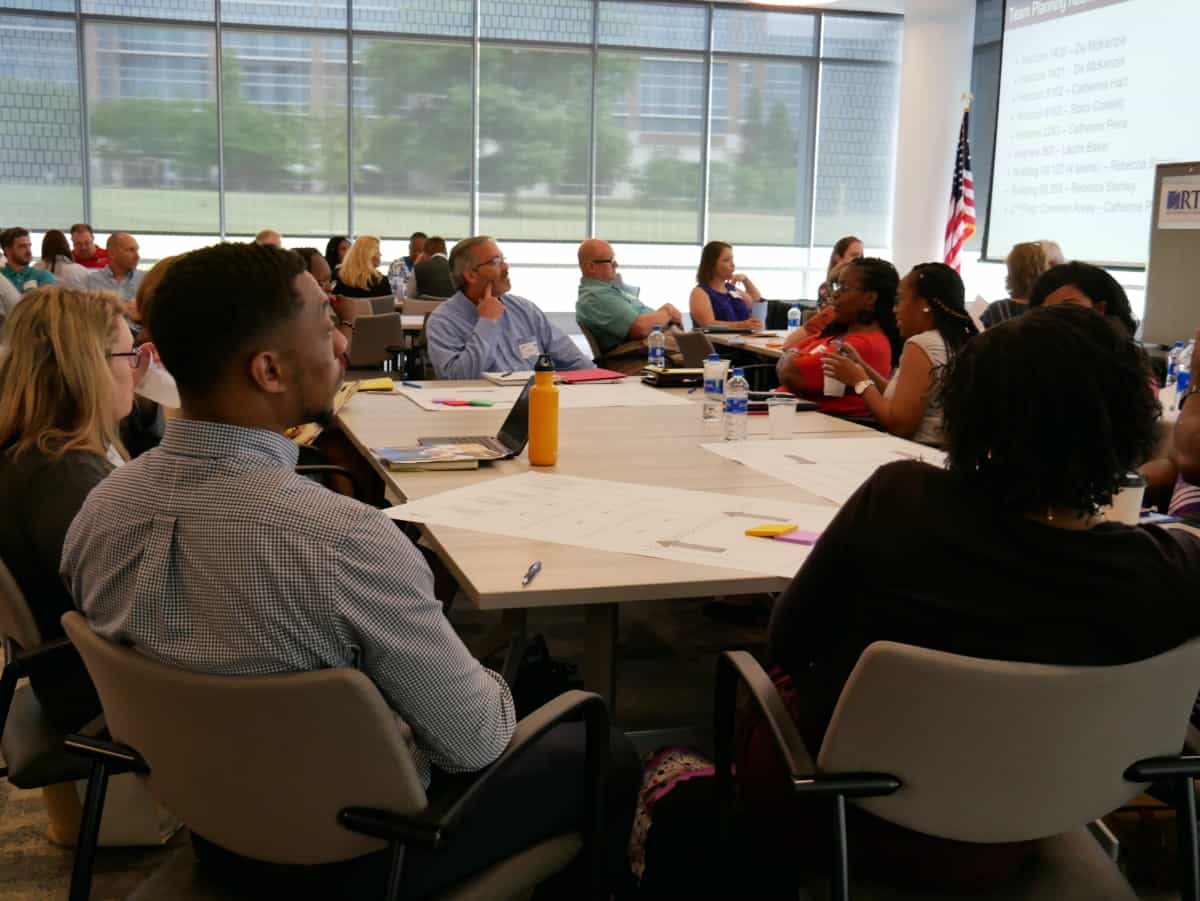When Jackie Harris started her first high school principalship at Granville Early College in Creedmoor, there had been lots of administrative turnover in the years since the school opened. Three years into leading the school under its early college model, Harris knew she needed support and a roadmap.
Harris got connected with a new network across North Carolina — a group of early colleges organized by RTI International. Two years ago, Harris and 15 other early college principals started working on a framework that would provide early college leaders with foundational principles and a template to set and reach goals for their schools and communities. Last week, that framework was given to around 200 early college educators at RTI International’s second annual Early College Summit.
“I was just getting my feet wet, and so I kind of knew that I needed some help and needed a foundation and needed somewhere to go, for experience at high school, period, and then to have my first high school experience and be an early college, is kind of a lot,” Harris said.
Early colleges provide students with smaller school environments, personalized instruction, and the chance to earn up to two years of college credits while still in high school. They are part of a larger state designation of over 100 public high schools in North Carolina called Cooperative Innovative High Schools (CIHS).
https://www.ednc.org/2019/01/07/cooperative-innovative-high-schools-what-are-they-and-why-does-north-carolina-have-so-many/
The framework shared at the summit last week has five design principles that describe what it is to be a “Next Generation Early College,” or “what early colleges need to become in the future to continue to meet the changing needs of our students and community:”
- “Demonstrates a commitment to creating an environment that supports the social and emotional learning of all students through a personalized approach,
- Exhibits teaching for learning through innovative instructional practice that builds student self-efficacy through active collaboration,
- Leverages the connections among school, home, the community and workplace to expand authentic learning opportunities and partnerships,
- Ensures that students are prepared for post-secondary education and careers in a rapidly changing global economy and
- Embodies a growth mindset for professionals that pushes boundaries through shared responsibility, reflective practice and inquiry.”
Under each principle are three attributes that display how early colleges are unique compared to traditional high schools. For example, under the first principle on social and emotional learning are attributes promoting the social/emotional health across the school community, personalization as the “heart beat” of the school, and a formal advisory structure at all levels.
Harris said a document like this one — that is flexible enough to change again and again — is helpful not only for current leaders but to pass on for administration and staff in the future.
“With upper-level administration changing constantly, teachers coming in and changing constantly, we need something that we can share with the people that are going to be there to know, again, what the mission and vision is, where we’re trying to go, what we need to do for our kids, and what kind of teachers we need to be able to do this,” she said.
As Harris shared the framework with other early college educators, she was thinking about a different document in the back of her mind: the proposed Senate budget, which would phase out extra state funding for CIHS’s over the next three years. Harris said she is worried students who do not fit traditional molds will struggle without the early college model.
“Talking about defunding, and I’m like, I don’t want to send my kids back to the real world, because they’ll get lost…” Harris said. “Or they’ll be in a corner, because they, a lot of them aren’t what we call normal kids. They don’t have the skills to communicate. We’re talking about transgender kids, we’re talking about a variety of different kids that just don’t fit in a traditional situation. And they need that extra — first you’ve got to work on the self-esteem, then you’ve got to have a support system.”
Harris said her personal relationships with students make a difference in their development and learning.
“Those kids get lost in a regular school,” she said. “They don’t have time to build those relationships. They don’t have the time to sit down and talk to them. You know, my kids call me. I have their cell numbers, they have my cell number. And you can’t do that when you’ve got 500-600 kids.”
Jodi Anderson, an education consultant with RTI Education Services, said RTI stepped in to serve as a statewide network for early colleges when a public-private partnership called NC New Schools Project closed in April 2016. The institute was excited, she said, to expand their work from research to practice.
“This is a research institute, so they are conducting research constantly in education, every area, but they said they really wanted the practitioner piece,” Anderson said. “So this team started and the first year we heard from principals very clearly that there was this tremendous need for professional development, for this network that they had had that was now gone. Because most of these schools are individual schools in their school district and they don’t look like any other school.”
The summit is held once a year, but RTI also holds professional development sessions throughout the year for early college principals, counselors and college liaisons, and soon-to-be teachers. The summit came out of principals who were network members wanting a space to bring their whole staff to plan for the next year, Anderson said. A network membership costs $2,500 and the summit costs $350 or $300 for existing network members.
Anderson said the potential funding cut would be devastating to early colleges across the state. Decisions would have to be made on the district level, she said, on how to support the school without the extra state funding, which is currently allocated based on economic tier. Those decisions would be very different depending on the wealth of the district.
“This is a school choice option that the legislature says is so important and yet the funding may not be there,” Anderson said. “…Where does that funding come from then? What do you cut to support this school?”
The difference ninth grade makes
The early college model has been studied for over a decade by a team of researchers who have found the model makes a statistically significant difference for students’ success in high school and postsecondary education. For more on that research, see the article below.
https://www.ednc.org/2019/01/08/the-difference-early-college-makes/
Beth Glennie, a senior education research analyst at RTI International, has been a part of that research from the beginning and led a summit breakout session that focused on the importance of ninth grade. Research shows ninth grade performance — both GPA and passing core academic courses — predicts high school graduation and college readiness and enrollment.
The early college study Glennie and others designed includes applicants to 19 different early colleges — the control group being the students who applied but were not accepted after a lottery. They have looked at five cohorts of ninth graders, from 2005-06 to 2009-10. Glennie shared that the team wanted to see if early college students get off track for college in the ninth grade at the same rate as traditional high school students and if those students who get off track have different characteristics in different settings. The team defined “off-track” as “failing to advance in a core English or math course in grade 9.”
The researchers found early college ninth graders get off track at about half the rate that traditional ninth graders do. Ninth grade math, Glennie said, is the biggest prohibiter from staying on-track. Students either are not passing it or not taking it. The study found 48% of off-track traditional ninth graders did not take a college-preparatory math course and 28% of off-track early college ninth graders didn’t.
“You have to think that, again, some of the students probably could pass it if they had the chance to take it,” Glennie said.
The study also found off-track ninth graders in both environments were more likely to be black, come from a low-income household, be a first-generation college-goer, and have failed end-of-grade tests in eighth grade. However, off-track early college ninth graders were less academically prepared and more disadvantaged than traditional off-track ninth graders.
Even though off-track early college ninth graders were more disadvantaged, Glennie said, they were also more likely to graduate and had fewer suspensions than off-track traditional students. More early college students became college-ready by the end of high school.
“When people just want to write off kids who get off track in ninth grade,” Glennie said. “… No, we need to really think about the fact that some of them (graduate).”
Glennie said research-proven strategies for preventing students from dropping out include many of the foundational principles of early colleges: using data to identify who needs help, assigning adult advocates to students, giving more academic support to students who need it, providing rigorous instruction, and personalizing learning.
Innovative grading based on growth
Another summit breakout session showcased the work of April Daywalt, a math teacher at Montgomery County Early College, who has a fresh take on grading. Daywalt led the room in discussing what grades means to different people and how EVAAS is used in their schools.
“(Grades) do mean something. They mean something to students, they mean something to families, they mean something to college boards,” said one early college principal. Many educators in the room said EVAAS is used to identify children who are struggling and to place students in small groups in order to differentiate instruction. One teacher said she sits students down one-on-one and shows them their EVAAS projections.
EVAAS is a tool developed by SAS that measures student growth year to year by comparing expected growth to actual growth. It comprises 20% of the state’s school performance grades (the other 80% comes from achievement). For more on the details of EVAAS, click on the article below.
https://www.ednc.org/2017/10/25/edexplainer-ins-outs-evaas/
Daywalt’s grading approach uses EVAAS to group her students and curve test scores. She said equity is the main principle behind this strategy — that students who will not master harder problems at first still need to be exposed to them.
“For the past six years, myself and a colleague… are actually using EVAAS projections to level the playing field as far as grading goes, where we can still provide higher level material to all students and maintain higher level expectations for all students, and while they’re getting there, it doesn’t necessarily penalize them grade-wise.”
Quizzes and in-class assignments are still based on proficiency — which is how we normally think of grade determination. But for bigger assessments, Daywalt’s approach is centered on growth. Daywalt splits her early college students into three groups based on their seventh grade EVAAS scores. After the test, she then finds the number of correct answers that represents the 75th percentile of each group. She then uses that number to curve scores. On a test with 20 questions, for example, if a certain group’s 75th percentile score was 14, she would grade out of 14 instead of out of 20.
“If you get kids on board, then everything else works out,” Daywalt said. Last year, she said all of her students were proficient on the end of year test and all students exceeded their projected growth standard. She said students at first would want to know their raw scores as well as their curved ones but that, eventually, they started to care about how they did compared to students like them.
“They start asking other teachers, ‘How will I know if I show growth?’ because it really makes them invested,” she said.
Daywalt also works with a math teacher at a different high school in the county to write tests, figure out which questions should stump which students, and compare results.
Heather Beane, an English teacher at Montgomery County Early College, said she saw a difference in the students Daywalt taught when they started taking college courses as sophomores.
“They were coming up from college classes saying, ‘Look, my first test grade was this and this is my second test grade. It’s still not where I want it but it’s better than it was,'” Beane said. “… The idea that this can help them understand growth and how growth is the most important thing and giving them that idea of, ‘How can I be better?’ I think that is something they carry with them forever.”


